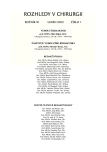Pharmacoresistant epilepsy after craniocerebral injury
Authors:
J. Chrastina 1,3; Z. Novák 1,3; I. Říha 1,3; K. Ghallab 1; L. Martínek 1; M. Brázdil 2,3
Authors‘ workplace:
Neurochirurgická klinika LF MU a FN u sv. Anny v Brně, Pekařská 5 , Brno
přednosta: Prof. MUDr. Zdeněk Novák, CSc
1; Centrum pro epilepsie Brno, I. neurologická klinika LF MU a FN u sv. Anny v Brně
přednosta: Prof. MUDr. Ivan Rektor, CSc
2; CEITEC - Středoevropský technologický institut, Masarykova univerzita, Brno
3
Published in:
Rozhl. Chir., 2012, roč. 91, č. 1, s. 18-25.
Category:
Original articles
Overview
Introduction:
Posttraumatic epilepsy is one of the possible serious consequencies of both closed and open head injury with clinical manifestation months or years after surgery. In pharmacoresistant patients, surgical therapy should be considered.
Material and Methods:
The study summarises the results of surgical treatment of pharmacoresistant posttraumatic epilepsy in a group of 13 patients (11 males and 2 females). Average age at the time of injury was 9,6 years in males and 8,8 years in females. The average number of seizures was 10,7–17 seizures/month preoperatively. Invasive EEG monitoring was required in 5 patients in whom non invasive or semiinvasive investigations failed to localize the epileptogenic zone adequately. Temporal lobe resections were performed in 4 patients, 4 patients underwent extratemporal resections and vagus nerve stimulation system was implanted in 5 patients.
Results:
Three patients (75%) after temporal resections became seizure free (Engel I) and in the remaining patient significant reduction of seizures was achieved (Engel III). There were 2 seizure free patients after extratemporal resections (50%) and significant reduction of seizure rates was achieved (Engel III) in the remaining two. One patient after vagus nerve stimulation met the criteria for > 90% response and there was a 50–90% seizure rate reduction in the remaining 4 patients (vagus nerve stimulation responder).
Conclusions:
Although in limited group of patients the study confirms good results of surgical treatment of selected posttraumatic epilepsy patients – mainly temporal epilepsy patients and patients after vagus nerve stimulation. Meticulous presurgical evaluation including invasive encephalography in indicated patients is a precondition for surgical success.
Key words:
head injury – epilepsy – surgical treatment – vagus nerve stimulation
Sources
1. Fuller G, Bouamra O, Woodford M, Jenks T, Patel H, Coasts TJ, Oakley P, Mendelow AD, Pigott T, Hutchinson PJ, Lecky F. Temporal trends in head injury outcomes from 2003 to 2009 in England and Wales. Br J Neurosurg 2011;25:414–421.
2. Hoshida T, Kobitsu K, Takeshima S, Hashimoto H, Kim YJ, Nakase H, Sasaki T. Head trauma related epilepsy. In: Kano T (Editor in Chief), Kato Y(Ed.): Minimally invasive neurosurgery and multidisciplinary neurotraumatology. Springer 2006;2:260–267.
3. Diaz-Arrastia R, Agostini MA, Madden CJ, Van Ness PC. Posttraumatic epilepsy: the endophenotypes of a human model of epileptogenesis. Epilepsia 2009;50(Suppl.2):14–20.
4. Chen JWY, Tiff RL, Eavey R, Wasterlain CG. Posttraumatic epilepsy and treatment. Journal of Rehabilitation Research and Development 2009;46:685–696.
5. Schierhout G, Roberts I. Prophylactic antiepileptic agents after head injury: A systematic review. J Neurol Neurosurg Psychiatry 1998;64:108–112.
6. Jensen RL, Stone JL. Benjamin Winslow Dudley and early American trephinations for posttraumatic epilepsy. Neurosurgery 1997;41:263–268.
7. Fine EJ, Reynolds D, Soria ED, Scalcione LR, Fine DL. The contributions of dr. Roswell Park to epilepsy and spinal surgery. Neurosurgery 1998;42:372–377.
8. Dbalý V. Epileptochirurgie dospělých. Praha, Grada Publishing, 2004.
9. Temkin NR. Preventing and treating posttraumatic seizures: the human experience. Epilepsia 2009;50 (Suppl.2):10–13.
10. Aarabi B, Taghipour M, Haghnegahdar A, Farokhi M, Mobley L. Prognostic factors in the occurence of posttraumatic epilepsy after penetrating head injury suffered during military service. Neurosurg Focus 2000;8(1):e1.
11. Pagni CA, Zenga F. Posttraumatic epilepsy with special emphasis on prophylaxis and prevention. Acta Neurochir 2005;93:27–34.
12. DęAmbrosio R, Perucca E. Epilepsy after head injury. Curr Opin Neurol 2004;17:731-735.
13. DęAmbrosio R, Fairbanks JP, Fender JS, Born DE, Doyle DL, Miller JW. Post- traumatic epilepsy following fluid percussion injury in the rat. Brain 2004;127:304–314.
14. Angeleri F, Majkowski J, Cacchio G, Sobieszek A, DęAcunto S, Gesuita R, et al. Posttraumatic epilepsy risk factors: one-year prospective study after head injury. Epilepsia 1999;40:1222–1230.
15. Servít Z, Musil F. Prophylactic treatment of posttraumatic epilepsy: results of a long term follow up in Czechoslovakia. Epilepsia 1981;22:315–320.
16. Hartzfeld P, Elisevich K, Pace M, Smith B, Gutierrez JA. Characteristics and surgical outcome for medial temporal posttraumatic epilepsy. Br J Neurosurg 2008;22:224–230.
17. Kuba R, Brázdil M, Novák Z, Pažourková M, Ošlejšková H, Chrastina J, Tyrlíková I, Rektor I. Dlouhodobá účinnost resekčních epileptochirurgických zákroků 5 let od operace. Neurol pro Praxi 2008;9:166–170.
18. Novák Z, Kuba R, Brázdil M, Chrastina J, Rektor I. Stimulace nervus vagus v terapii farmakorezistentní epilepsie. Neurol pro Praxi 2004;2:63–66.
19. Téllez-Zenteno JF, Dhar R, Wiebe S. Long-term seizure outcomes following epilepsy surgery: a systematic review and meta-analysis. Brain 2005;128:1188–98.
20. Devaux B, Chassoux F, Guenot M, Haegelen C, Bartolomei F, Rougier A, et al. Epilepsy surgery in France. Neurochirurgie 2008;54:453–465.
21. Elsharkawy AE, Behne F, Oppel F, Pannek H, Schulz R, Hoppe M, et al. Long term outcome of extratemporal epilepsy surgery among 154 adult patients. J Neurosurg 2008;108:676–686.
22. Swartz BE, Houser CR, Tomiyasu U, Walsh GO, deSalles A, Rich JR, et al. Hippocampal cell loss in posttraumatic epilepsy. Epilepsia 2006;47:1373–1382.
23. Lee HO, Koh EJ, Oh YM, Park SS, Kwon KH, Choi HY. Effect of vagus nerve stimulation in posttraumatic epilepsy and failed epilepsy surgery: Preliminary report. J Korean Neurosurg Soc 2008;44:196–198.
Labels
Surgery Orthopaedics Trauma surgeryArticle was published in
Perspectives in Surgery

2012 Issue 1
Most read in this issue
- Fascial closure of the abdominal wall by dynamic suture after topical negative pressure laparostomy treatment of severe peritonitis – results of a prospective randomized study
- Pharmacoresistant epilepsy after craniocerebral injury
- Urethral catheter as a risk factor of urologic complications after total knee arthoplasty – the retrospective analysis
- Stab wounds in children
